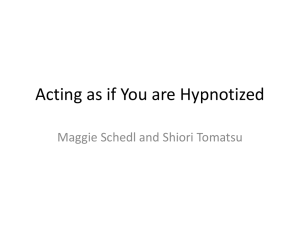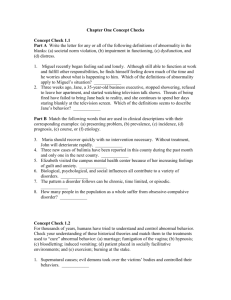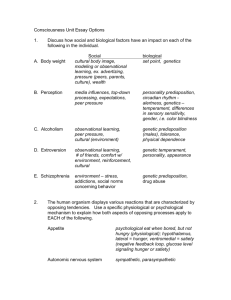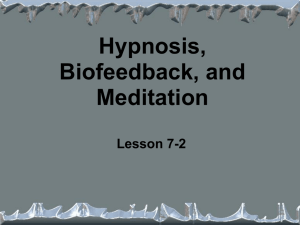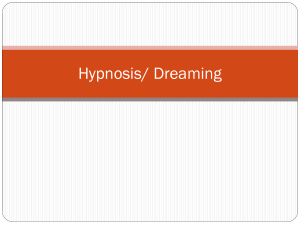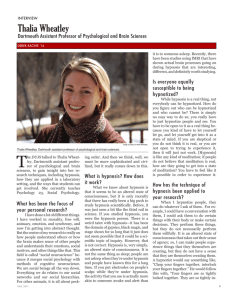Onwards to Erickson - British Association of Medical Hypnosis
advertisement
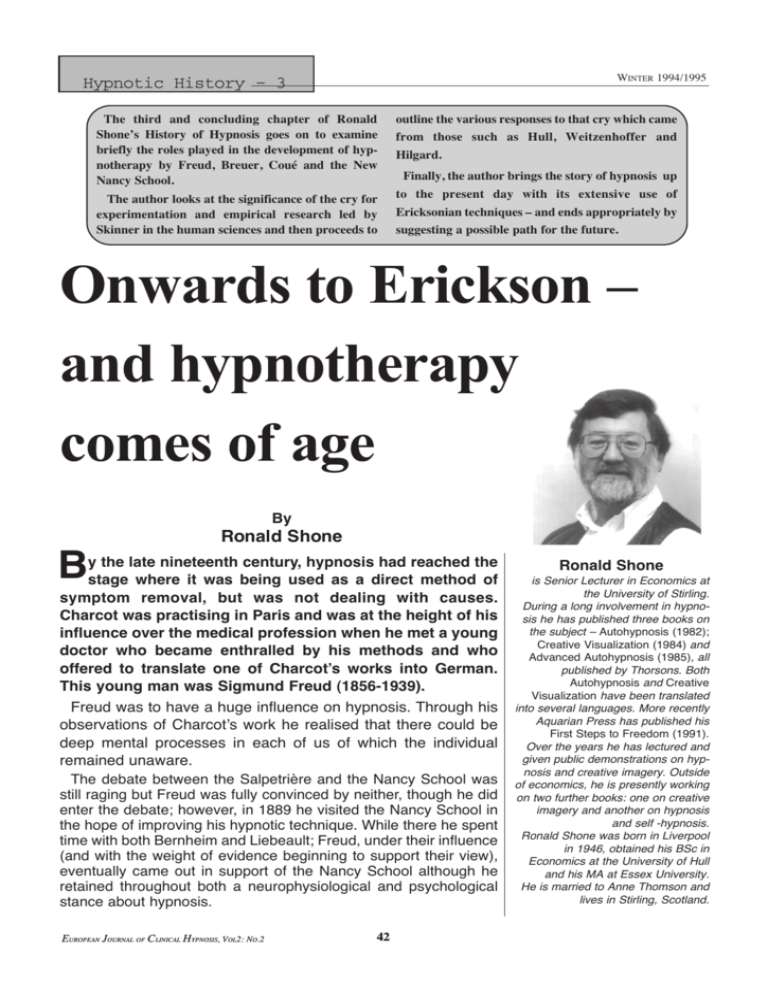
WINTER 1994/1995 Hypnotic History – 3 The third and concluding chapter of Ronald Shone’s History of Hypnosis goes on to examine briefly the roles played in the development of hypnotherapy by Freud, Breuer, Coué and the New Nancy School. The author looks at the significance of the cry for experimentation and empirical research led by Skinner in the human sciences and then proceeds to outline the various responses to that cry which came from those such as Hull, Weitzenhoffer and Hilgard. Finally, the author brings the story of hypnosis up to the present day with its extensive use of Onwards to Erickson – and hypnotherapy comes of age B By Ronald Shone Ericksonian techniques – and ends appropriately by suggesting a possible path for the future. y the late nineteenth century, hypnosis had reached the stage where it was being used as a direct method of symptom removal, but was not dealing with causes. Charcot was practising in Paris and was at the height of his influence over the medical profession when he met a young doctor who became enthralled by his methods and who offered to translate one of Charcot’s works into German. This young man was Sigmund Freud (1856-1939). Freud was to have a huge influence on hypnosis. Through his observations of Charcot’s work he realised that there could be deep mental processes in each of us of which the individual remained unaware. The debate between the Salpetrière and the Nancy School was still raging but Freud was fully convinced by neither, though he did enter the debate; however, in 1889 he visited the Nancy School in the hope of improving his hypnotic technique. While there he spent time with both Bernheim and Liebeault; Freud, under their influence (and with the weight of evidence beginning to support their view), eventually came out in support of the Nancy School although he retained throughout both a neurophysiological and psychological stance about hypnosis. EUROPEAN JOURNAL OF CLINICAL HYPNOSIS, VOL2: NO.2 42 Ronald Shone is Senior Lecturer in Economics at the University of Stirling. During a long involvement in hypnosis he has published three books on the subject – Autohypnosis (1982); Creative Visualization (1984) and Advanced Autohypnosis (1985), all published by Thorsons. Both Autohypnosis and Creative Visualization have been translated into several languages. More recently Aquarian Press has published his First Steps to Freedom (1991). Over the years he has lectured and given public demonstrations on hypnosis and creative imagery. Outside of economics, he is presently working on two further books: one on creative imagery and another on hypnosis and self -hypnosis. Ronald Shone was born in Liverpool in 1946, obtained his BSc in Economics at the University of Hull and his MA at Essex University. He is married to Anne Thomson and lives in Stirling, Scotland. WINTER 1994/1995 Hypnotic History – 3 Breuer and Freud used hypnosis to unlock unconscious repressions Around the same time Josef Breuer (18421925) was eliminating the symptoms of hysteria by an indirect method – he got his patients to verbalize their problems while in a hypnotic state. Freud and Breuer met at Brucke’s Physiological Institute in the late 1870s and they soon became very good friends, sharing each other’s scientific interests. Development of Psychoanalysis Freud hypothesized that the same must be true of his non-hypnotisable patients and that another method was needed to unlock the unconscious thoughts. Furthermore, he was having doubts about the suitability of hypnosis for symptom removal, since he found that in some cases removing one symptom simply led to another in its place. Thus emerged Freud’s free association analytic method and his analysis of dreams. As Freud was developing his psychoanalytical method, interest in hypnosis continued at Nancy but taking on a different approach based on the work of Emile Coué (1857-1926). Like Freud, Coué became interested in hypnosis after seeing the work of Liebeault. His main ideas, however, were made popular by Baudouin - just as Liebeault’s ideas were made popular by Bernheim. Freud, however, was slow to implement Breuer’s method on his return to Paris (no doubt because Charcot did not much approve). He began to do so in 1889 on a woman patient whom he found to be somnambulistic; but his first full length treatment using Breuer’s method did not occur until 1892. Freud began to use hypnosis on hysterical patients as a means of helping them recall the precise circumstances which led to their symptoms, publishing his experiences and those of Breuer in his “Studies on Hysteria”. Of importance to our study is the fact that Breuer and Freud used hypAutosuggestion nosis to unlock unconscious repressions which had been The ideas of the New the cause of mental illness. Nancy School, as it became By 1887 Freud was using known, were set out in hypnosis on his patients Baudouin’s Suggestion and almost exclusively – though Auto-suggestion. In brief, the with varying success. Some New Nancy School argued that were not hypnotisable, others did the main factor in hypnosis was not go deep enough – he, and othautosuggestion. ers, thought that a deep somnambuAn immediate consequence of this listic state was necessary to obtain a was that in some circumstances it was cure. possible to elicit a cure without another person making suggestions, i.e. without Dr Sigmund Freud Freud was discovering that hypnosis hetero-suggestion. did have its drawbacks for purposes of therapy, but while visiting Burnheim he Second, the ‘law of reverse effect’ was was informed that although somnambulists did not of fundamental importance to success. Third, the normally recall what took place under hypnosis main effects of autosuggestion occurred at the when they were in their normal waking state, they unconscious level. could be instructed to do so! 43 EUROPEAN JOURNAL OF CLINICAL HYPNOSIS, VOL2: NO. 2 WINTER 1994/1995 Hypnotic History – 3 The British Medical Association published a report which concluded that hypnosis was a real phenomenon . . . These developments, although not inconsistent with psychoanalysis, were overshadowed by it. They did, however, indicate that self-hypnosis was possible. Until this time all hypnosis had been heterohypnosis – largely because it was believed it must be induced by someone else. If – as the New Nancy School argued – hypnosis involved autosuggestion, then heterohypnosis was simply one form it could take. There should, in principle, be no difficulty in a person inducing hypnosis in themselves if they believed in it sufficiently. In 1892 the British Medical Association published a report which concluded that hypnosis was a real phenomenon which could be beneficially used on some patients. They emphasised particularly its therapeutic value in the control of pain, in inducing sleep, and other problems of a non-physical nature. The report was largely ignored. A resurgence of interest in hypnosis arose during the First World War when there was need for a quicker cure for wartime neuroses. Hypnosis was found to be most effective in relieving symptoms through reliving war experiences. The same was true during and after the Second World War and the Korean War. The Period of Experimentation These developments were still following the approach that hypnosis was a method of dealing with psychological problems – what is known now as hypnotherapy. But the rise of behaviourism, due to the work of B.F. Skinner, encouraged a general move towards a more scientific (empirical) approach in all the human sciences. This trend was reflected in hypnosis, with a preference for experimental work such as that shown in the investigations of Clark L Hull, and published in his “Hypnosis and suggestibility: an experimental approach” in 1933. This was the first major work to apply the experimental and statistical methods of psyEUROPEAN JOURNAL OF CLINICAL HYPNOSIS, VOL2: NO.2 44 chology to hypnosis and suggestibility. The work attempted to study some of the major claims that were being made about hypnosis. It will be recalled that the group at Salpetrière argued that hypnosis was pathological and only individuals with hysterical dispositions could be hypnotised. The New Nancy view, however, was that hypnosis was a normal process, that suggestibility was at the heart of the phenomenon and therefore almost everyone could be hypnotised, since everyone under suitable conditions would manifest some degree of suggestibility. Suggestibility Scales Hull and his colleagues began with a scale in which various suggestibility phenenomena were arranged in observed order of difficulty from simple relaxation to amnesia and hallucination. This was the beginning of the suggestibility scales that have now become prominent. Although finding no evidence for the transcendence of normal activity Hull did, nonetheless, verify many of the classical phenomena observed under hypnosis. The experimental approach expanded further in the 1950s and 1960s with the work of Theodore X. Barber, Ernest. R. Hilgard, Martin T. Orne and Theodore R. Sarbin. A major emphasis of this period was the construction of normalised suggestibility scales, of which the Barber scale and the Stanford hypnotic suggestibility scales devised by A. M. Weitzenhoffer and Ernest Hilgard are the best known and most widely used. The experimental approach has continued in the areas of hypnosis and pain and personality correlates with hypnosis. The experimental investigation into pain and hypnosis highlights some of the issues. WINTER 1994/1995 Hypnotic History – 3 We have already pointed out that both Elliotson and Esdaile performed surgery on patients who were under hypnosis with the result that the patients felt no pain. For the moment let us agree that the subjects were not lying or pretending. The question then is whether they actually felt no pain or whether they simply reported that they felt no pain. How can this be tested? Pain is a sensation felt in the nervous system which sends messages to the brain. One conjecture is that if no message is sent to the brain then no pain can be ‘felt’ – the individual will not be conscious of any pain. In a famous experiment Hilgard first hypnotised a subject and then by suggestion ‘removed’ any sense of pain. The subject reported no sense of pain. However, through automatic writing, where the subject was not aware of what he wrote, he did admit to feeling pain. This suggests that hypnotic anaesthesia and analgesia are dissociative phenomena. The experimental approach has its limitations. The object of hypnosis is to suspend the analytical faculties and the experimental approach makes this extremely difficult, except in the most suggestible of subjects. Even so, these researches have provided some invaluable insights into the hypnotic state. When the subject matter of hypnosis was focused on the hypnotist and the hypnotic technique a certain domain and set of constant techniques were implied. However, a switch of focus to the subject meant that the hypnotist had to become more flexible, more adaptable and more dynamic: both in terms of hypnosis and in terms of therapy. It has been argued that this is why Erickson often succeeded with difficult subjects where other hypnotherapists failed. Although this approach creates problems in the experimental study of hypnosis, it has profound implications for hypnotherapy. The Work of Milton Erickson There was little change in the study and practice of hypnosis for 200 years until the recent work of Milton Erickson. He developed a new approach to hypnosis which has now spawned a vast literature and is the basis of neuro-linguistic programming (NLP). The essential ingredient of the ‘Ericksonian approach’ is that the hypnotist interacts with the mode of thought, speech and mannerisms of the subject. Suggestions are made indirectly, often in a roundabout way, leaving the subject to interpret them in an appropriate way – which means that every response is a valid one. It is a dynamic approach to hypnosis, especially to hypnotic induction, where the hypnotist is constantly having to adapt his or her technique in line with the demands, expectations and wishes (conscious or unconscious) of the subject. There is, therefore, a shift of focus from the hypnotist to the subject. Milton Erickson There has always been a debate in the social sciences concerning generalised theories versus the case study approach. Hypnosis has certainly not produced generally accepted theories and it has also suffered from the lack of a general framework for case 45 EUROPEAN JOURNAL OF CLINICAL HYPNOSIS, VOL2: NO. 2 WINTER 1994/1995 Hypnotic History – 3 Accepting just one explanation of hypnosis – whether Freudian, Jungian or Ericksonian – can only straight-jacket the therapist simply rules for good rapport does not detract from the fact that it has given a new and refreshing life to the subject of hypnosis. Unfortunately, like many other schools of thought, the disciples of Erickson have accepted his approach almost without question, and disregard all that has gone before. The Ericksonian approach does have something to offer but, as this history makes clear, it is not the whole explanation of hypnosis and therefore cannot be the only technique to follow or use. Until we understand the phenomenon of hypnosis more fully it would be foolhardy to accept just one view, just one explanation, of hypnosis to the exclusion of all else. Accepting just one, whether Freudian, Jungian or Ericksonian, can only straight-jacket the therapist. If the Ericksonian approach teaches anything, it is that the therapist must be open minded and flexible and must not bring his or her own prejudices into the therapeutic session. The Ericksonian approach lends itself very well to a detailed case study approach. Generalisations can be made, based on such case studies, but general theories are not possible at present. Given that the focus of hypnotism is on the subject then the case study approach is inevitably the most appropriate one. General Princples There is, of course, the possibility that ‘anything goes’, thus rendering the approach vacuous, like a ‘theory’ which applies to all in all circumstances – it becomes no theory at all! This is not the case with the Ericksonian approach. There are general principles underlying it. This was demonstrated by Grinder and Bandler and by Rossi. Elements in the approach include: l l l l l l Permissive use of language. Allowing people to be as they are and utilizing what they are and how they think. Approaching hypnotic induction in a ‘naturalistic’ manner and utilizing the subject’s inner world. Language and behaviour of the therapist being based on supposing what will happen is going to happen. Matching the responses (verbal and nonverbal) of the subject. Approaches such as splitting (e.g. conscious and unconscious) and linking. Present and future The emphasis of hypnosis today is on its therapeutic use. Hypnotherapy is a tool used for a wild field of conditions, from more clinical uses such as in dentistry and obstetrics to a variety of problems such as diet, skin disorders or sexual dysfunction. Equally significant is its growing use in dealing with stress and related problems: hypnotherapy is a coping empowerer. It has been used for some time to effect behaviour modification, but this aspect has really only relatively recently been seen as a means of realising potential in many aspects of daily life. In other words, hypnotherapy implies that hypnosis is used for overcoming some ‘problem’ which requires ‘therapy’. Achieving full potential is not a problem per se and so the use of hypnosis in this regard (especially self hypnosis) should not be thought of as ‘therapy’ – more as an aid to self-development. As I see it, the main evolution of hypnosis will occur in the realms of self-development and as a non-toxic means of dealing with stress. What is apparent from this list is that they all involve means of good communication, of achieving a good rapport with the subject. Rapport has always been important for hypnosis, but what constitutes good rapport has been hard to define. It is possible to argue that the Ericksonian approach, rather than being completely new, is simply a very good set of guidelines for achieving good rapport with a subject. Whether it represents a brand new approach or EUROPEAN JOURNAL OF CLINICAL HYPNOSIS, VOL2: NO.2 46

